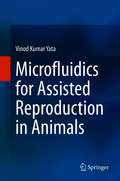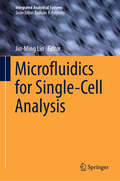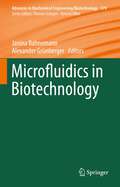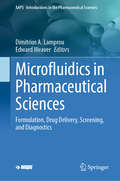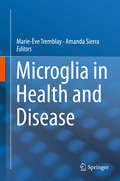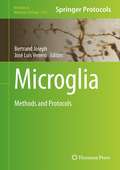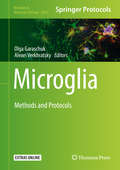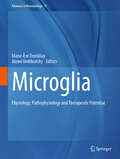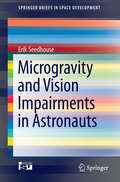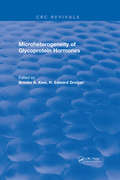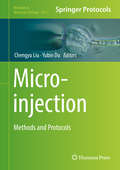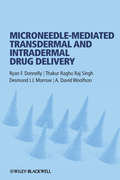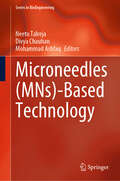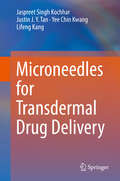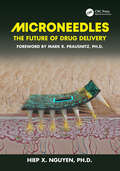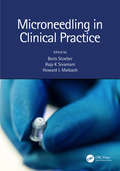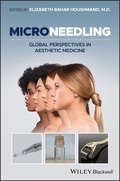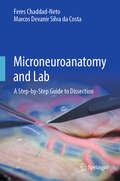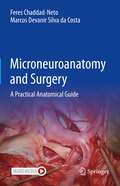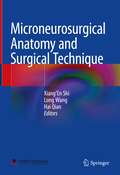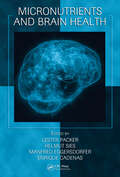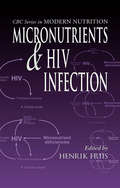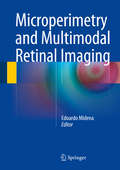- Table View
- List View
Microfluidics for Assisted Reproduction in Animals
by Vinod Kumar YataThis book describes the fundamentals of microfluidics and fabrication methods of microfluidic devices that can be adopted for animal-assisted reproduction. It presents microfluidic methods for sorting highly fertile spermatozoa. This book also describes the application of microfluidics in vitro fertilization and embryo culture. It discusses the use of microfluidics in sperm sexing and the cryopreservation of animal gametes and embryos. Lastly, the book examines the potential opportunities of microfluidics in infertility diagnosis, sperm selection and guidance, oocyte selection, insemination, and embryo monitoring.
Microfluidics for Single-Cell Analysis (Integrated Analytical Systems)
by Jin-Ming LinThis book summarizes the various microfluidic-based approaches for single-cell capture, isolation, manipulation, culture and observation, lysis, and analysis. Single-cell analysis reveals the heterogeneities in morphology, functions, composition, and genetic performance of seemingly identical cells, and advances in single-cell analysis can overcome the difficulties arising due to cell heterogeneity in the diagnostics for a targeted model of disease. This book provides a detailed review of the state-of-the-art techniques presenting the pros and cons of each of these methods. It also offers lessons learned and tips from front-line investigators to help researchers overcome bottlenecks in their own studies. Highlighting a number of techniques, such as microfluidic droplet techniques, combined microfluidics-mass-spectrometry systems, and nanochannel sampling, it describes in detail a new microfluidic chip-based live single-cell extractor (LSCE) developed in the editor’s laboratory, which opens up new avenues to use open microfluidics in single-cell extraction, single-cell mass spectrometric analysis, single-cell adhesion analysis and subcellular operations. Serving as both an elementary introduction and advanced guidebook, this book interests and inspires scholars and students who are currently studying or wish to study microfluidics-based cell analysis methods.
Microfluidics in Biotechnology (Advances in Biochemical Engineering/Biotechnology #179)
by Janina Bahnemann Alexander GrünbergerThis new volume introduces the applications of microfluidic systems to facilitate biotechnological and biomedical processes. It provides an overview on cutting-edge technologies, summarizes traditional and modern fabrication methods and highlights recent advances regarding the application of lab-on-a-chip (LoC) systems for bioanalytical purposes. This book is ideal for research scientists and students interested at the cross-section between biotechnology, chemistry and chemical engineering.
Microfluidics in Pharmaceutical Sciences: Formulation, Drug Delivery, Screening, and Diagnostics (AAPS Introductions in the Pharmaceutical Sciences #14)
by Dimitrios A. Lamprou Edward WeaverThe book covers the basics of microfluidics, current applications in areas such as formulation, drug delivery, drug screening and development, monitoring and diagnostics, and case studies from a teaching perspective to undergraduate and postgraduate students, allowing application of the content in a flipped classroom. Multiple choice questions are included at the end of each chapter. All chapter authors are pioneers and world leaders. This is an ideal book for students, researchers, and industry professionals working on microfluidics in the pharmaceutical sciences.
Microglia in Health and Disease
by Marie-Ève Tremblay Amanda SierraThese past few years have witnessed a revolution in our understanding of microglia, especially since their roles in the healthy central nervous system (CNS) have started to unravel. These cells were shown to actively maintain health, in concert with neurons and other types of CNS cells, providing further insight into their involvement with diseases. Edited by two pioneers in the field, Marie-Ève Tremblay and Amanda Sierra, Microglia in health and disease aims to share with the broader scientific community some of the recent discoveries in microglia research, from a broad perspective, with a collection of 19 chapters from 52 specialists working in 11 countries across 5 continents. To set microglia on the stage, the book begins by explaining briefly who they are, what they do in the healthy and diseased CNS, and how they can be studied. The first section describes in more details their physiological roles in the maturation, function, and plasticity of the CNS, across development, adolescence, adulthood, neuropathic pain, addiction, and aging. The second section focuses on their implication in pathological conditions impairing the quality of life: neurodevelopmental and neuropsychiatric disorders, AIDS, and multiple sclerosis; and in leading causes of death: ischemia and stroke, neurodegenerative diseases, as well as trauma and injury.
Microglia: Methods and Protocols
by José Luis Venero Bertrand JosephKey discoveries concerning the different biological functions of microglia in health and disease have attracted scientists from various fields. In Microglia: Methods and Protocols, expert researchers in the field detail methods for selection of the key cellular, molecular and biochemical techniques that are used in studying the many and varied functions of this fascinating cell. These methods and techniques include microglia cell culture for studying microglia activation and functions, as well as their interaction with other cell types both in vitro and in vivo. Written in the highly successful Methods in Molecular Biology series format, chapters include introductions to their respective topics, lists of the necessary materials and reagents, step-by-step, readily reproducible laboratory protocols, and key tips on troubleshooting and avoiding known pitfalls. Authoritative and practical, Microglia: Methods and Protocols is a useful resource for cell biologists, molecular biologists, immunologists, oncologist and neuroscientists.
Microglia: Methods and Protocols (Methods in Molecular Biology #2034)
by Alexei Verkhratsky Olga GaraschukThis book presents a comprehensive toolkit of versatile techniques for studying microglia under different experimental settings along with a brief summary of knowledge, accumulated in microglial research over the last decades. Beginning with recently discovered roles of microglia in health and disease, the volume continues by covering in vitro analyses of microglia, in vivo studies, and “omics” analyses. Written for the highly successful Methods in Molecular Biology series, chapters include introductions to their respective topics, lists of the necessary materials and reagents, step-by-step, readily reproducible laboratory protocols, and tips on troubleshooting and avoiding known pitfalls. Authoritative and cutting-edge, Microglia: Methods and Protocols serves as a vital guide to these important cells and an inspiration for scientists interested in expanding our knowledge of their role in the nervous system.
Microglia: Physiology, Pathophysiology and Therapeutic Potential (Advances in Neurobiology #37)
by Alexei Verkhratsky Marie-Ève TremblayThe past decade has witnessed a revolution in our understanding of microglia, especially since their roles in the healthy CNS have started to unravel. These cells were shown to actively maintain health, in concert with neurons and other types of CNS cells, providing further insight into their crucial involvement with diseases. Edited by Drs. Marie-Ève Tremblay and Alexei Verkhratsky, Microglia: Physiology, Pathophysiology and Therapeutic Potential shares with the scientific and medical community the latest discoveries in the microglial research field, with a truly comprehensive collection of chapters written by the top specialists across five continents. The book begins by explaining briefly what they are, from both historical and evolutionary points of view, and how they can be studied. The first section explains their physiological roles in the maturation, function, and plasticity of the CNS. The second section focuses on their general involvement in neuropathophysiology, and the third section on their critical implication in specific CNS diseases, including neurotrauma, neuropathic pain, ischemia and stroke, infectious diseases, autoimmune diseases, neurodevelopmental and neuropsychiatric disorders, substance use and addiction, sleep disorders, ageing, and neurodegenerative diseases. The fourth section presents their clinical potential as a targeted therapeutic tool for these CNS diseases.
Microgravity and Vision Impairments in Astronauts
by Erik SeedhouseRecent missions on board the International Space Station have revealed previously unreported physiological consequences of long duration space flight, particularly in eyesight, and in this Brief Dr. Seedhouse reviews the existing theories on what causes this degeneration and how long it will last. Notably, 60% of long-duration crews have reported subjective degradation in vision, a clear indication that further study is necessary before astronauts embark on even longer-term space missions. Decreased near-visual acuity was reported in 46% of ISS/Mir crewmembers, resulting in a change of up to 2 dioptres in their refractive correction. It is possible that ophthalmic changes have been present since the first days of spaceflight, but had been attributed to other causes; this approach to the issue as well as other hypotheses are all presented in full to give a broad foundation of the existing knowledge on the topic. The changes have occurred at various times during a mission with varying degrees of visual degradation. Some cases resolved on return to Earth, but several crewmembers have not regained pre-flight visual acuity, indicating the damage may be permanent. One explanation of the syndrome has been attributed to hyperopic shift due to aging, but onboard analysis techniques, including visual acuity assessments, retinal imagery, and ultrasound examination of the eye, has led to the acceptance of a wider syndrome. In addition to vision changes, studies have reported flattening of the globe, swelling of the optic disc (papilledema), choroidal folds in the retina, swelling of the optic nerve sheath, and visual field defects. It is widely hypothesized that this spectrum of symptoms may be explained by an elevation of intracranial pressure (ICP). Establishing the provenance of this medical problem, monitoring its occurrence and resolving the symptoms for future long term space missions is a key challenge for space medicine. With this book, readers have an entry point for understanding the full scope of the problem and its possible origins.
Microheterogeneity of Glycoprotein Hormones
by B.A. KeelEleven contributions review our knowledge of the characterization of glycoprotein hormone microheterogeneity, the relationships between biological activity and microheterogeneity, the endocrinological control mechanisms involved in the production of these forms and the underlying biochemical basis for glycoprotein hormone microheterogeneity. Organized so that the heterogeneity of each hormone from a variety of species is covered in detail, the peptide components and oligosaccaride stuctures of glycoprotein hormones are reviewed, and the heterogeneity of uncombined alpha and beta subunits is discussed.
Microinjection: Methods And Protocols (Methods in Molecular Biology #1874)
by Chengyu Liu Yubin DuThis detailed book explores how microinjection will be used in the foreseeable future, not only for generating animal models for biomedical research but also for changing economically or ecologically important species that can broadly impact our society in general. The opening half of the book focuses on methods for generating mouse models, as they are still the most popular in genome engineering research, while the second half examines gene-editing in a variety of other species, opened up by the developments in ZFN, TALEN, and CRISPR techniques. Written for the highly successful Methods in Molecular Biology series, chapters include introductions to their respective topics, lists of the necessary materials and reagents, step-by-step, readily reproducible laboratory protocols, and tips on troubleshooting and avoiding known pitfalls. Authoritative and practical, Microinjection: Methods and Protocols serves as an ideal guide for researchers looking to take advantage of the breakthrough technologies in gene-editing and embryo micromanipulations.
Microneedle-mediated Transdermal and Intradermal Drug Delivery
by Desmond I. Morrow A. David Woolfson Ryan F. Donnelly Thakur Raghu SinghOne of the latest techniques in drug delivery, microneedles are used for administering a wide range of drug substances used to treat various medical conditions. Thorough background information is included providing a history of the field. Various methods used to produce micorneedles are described as well as a snapshot of the future directions within the industry. Written by highly qualified authors, this new text is the only title providing a comprehensive review of microneedle research in the fields of transdermal and intradermal drug delivery.
Microneedles (Series in BioEngineering)
by Neetu Talreja Divya Chauhan Mohammad AshfaqThis book highlights the fabrication of various types of solid, hollow, and dissolvable microneedles (MNs) using various synthesis processes and their applications in medicine, agriculture, and sensors. MN-based technology emerges as a sign of hope, offering a painless delivery system. In general, MN-based technology uses tiny needles to puncture the outermost layer of the skin. MNs are made of various materials like metals, silicon, and polymers for efficient delivery of biomolecules. With the tremendous success of MNs in the drug delivery system, researchers try to use MNs in agriculture and sensor applications to improve plant health via monitoring and delivery of agrochemicals. By modulating the materials of MNs, drugs and biomolecules can be delivered in a controlled manner. In general, MN-based technology holds significant opportunities for improving delivery of the drugs/biomolecules and opens new wings toward agriculture and sensing applications. Moreover, MN-based technology enables newer avenues for therapeutic and diagnosis of diseases.
Microneedles for Transdermal Drug Delivery
by Jaspreet Singh Kochhar Yee Chin Kwang Lifeng Kang Justin J. TanThis monograph covers a novel technology to deliver drugs and cosmetics through the skin in a minimally invasive manner. Microneedles – a bed of miniaturized needles is one of the most studied topics in delivering actives through the skin barrier. This book enables readers to understand the delivery of ingredients through the skin, describes a novel and simple method to fabricate microneedles containing a range of small and large molecular weight compounds, studies their physical properties as well as delivery through the skin layers. Readers will discover this book to be extremely beneficial to help them understand the state of the field of transdermal drug delivery, with extensive coverage including experimental data on basics of microneedle fabrication technology using photolithography, encapsulation of drugs within the polymeric matrix of microneedles and studying their release patternsin vitro and ex vivo . Academic researchers, pharmaceutical and cosmeceutical industry as well as students of skin science will find this account very useful in their pursuits. As microneedles grow and develop into a commercial reality with more actives being delivered and significant clinical research being put in, this account will hold well in providing basic principles and knowledge together with rigorous experimental data.
Microneedles: The Future of Drug Delivery
by Hiep Xuan NguyenThe microneedle field has been expanding exponentially with innovative designs and various applications, thus capturing the interest of academic industry and regulatory sectors. Microneedles: The Future of Drug Delivery equips readers with a comprehensive understanding of microneedles: from percutaneous absorption to microneedles production, characterization, applications in drug delivery and diagnosis, to practical perspectives on the development, manufacturing, regulatory issues, and commercialization of microneedles. This book is written by a single author and thus provides complex information in a simple, elegant, and cohesive style. The book is intended for graduate students, researchers, scientists, and engineers working in the pharmaceutical, medical, cosmeceutical, and biotechnology industry.
Microneedling in Clinical Practice
by Howard I. Maibach Boris Stoeber Raja K SivamaniMicroneedles provide an artificial pathway across the skin barrier for medical and cosmetic applications. This technology has seen a significant increase in popularity over the past years; as an example, the use of multiple small needles mounted on a roller to pierce the skin, prompting it to stimulate collagen production, has undergone a resurgence of interest as an adjunctive procedure for a number of skin disorders. This monograph draws together what is known about how to integrate microneedle technology into clinical dermatologic practice.
Microneedling: Global Perspectives in Aesthetic Medicine
by Elizabeth Bahar HoushmandA complete guide to microneedling and its varied roles in modern aesthetic medicine Microneedling is an increasingly common procedure in the day-to-day practice of dermatologists across the globe. Minimally invasive and requiring minimal downtime, the process can be used to address a range of cosmetic and dermatologic concerns, including rejuvenation of the skin, transdermal delivery of drugs, skin textural irregularities, luminosity, and treatment of dyschromia, melasma, and scarring. Treatment is administered with pens, rollers, and, stamps that have been designed to stimulate the release of growth factors and induce collagen production, working to enhance the appearance of patients of all ages and skin types. Edited by leading dermatologist Dr. Elizabeth Bahar Houshmand, Microneedling brings together practical instruction, top tips, and exciting new research to provide all those working in aesthetic medicine with an essential guide to this multifaceted procedure. The book includes a global approach and insightful discussion of topics including: The therapeutic benefit of microneedling when skin injury, disease, or aging causes aesthetic changes in the skin The advantages of microneedling, including its decreased risk of pigmentation changes or scarring compared with other procedures The practical skills and technology used in the implementation of different microneedling techniques Tips for applying microneedling to a wide range of skin types The use of microneedling to inject platelet-rich plasma Based upon the latest research and industry practices, Microneedling is an invaluable tool for all dermatologists, dermatologic surgeons, and other aesthetic medicine practitioners looking to provide their patients with the best possible care.
Microneuroanatomy and Lab: A Step-by-Step Guide to Dissection
by Feres Chaddad-Neto Marcos Devanir CostaDetailed knowledge of nervous system anatomy and microsurgical training in the laboratory are essential to understanding the brain. This practical book introduces the Neuroanatomical Lab for medical students, neurosurgical and neurology residents, and neurosurgeons. It addresses all the basic tenets of the laboratory routine, specimens&’ preparations and also details all types of brain dissections. How to build a Microneurosurgical Lab? How to prepare models for microsurgical training? How to start the Lab Training? How to dissect the important anatomical regions of the brain? All of these questions are discussed in the 15 didactic chapters and are richly illustrated by images. More than an educational manual, this is a fascinating step-by-step guide to starting the anatomical dissection of the brain and for microsurgical training. From basic to advanced, this work reflects the authors extensive experience, making it an indispensable tool for students and practitioners interested in understanding the brain in-depth.
Microneuroanatomy and Surgery: A Practical Anatomical Guide
by Feres Chaddad-Neto Marcos Devanir Silva da CostaMicroneuroanatomy is essential to understanding the brain. In many cases, passing on neuroanatomical knowledge is a difficult task to accomplish, yet this is chiefly due to those who are tasked with conveying this knowledge in classes and lectures, or in books. In reality, neuroanatomy is simple and needs to be understood as a tool for approaching the different areas of the brain, not as an obstacle, and the only way to overcome this problem is to correlate neuroanatomy with various types of disease (arteriovenous malformations, aneurysms, tumors, cavernomas, hydrocephalus, etc.) This book provides a novel approach to the relation between microneuroanatomy and brain diseases. Each chapter addresses a specific neuroanatomical region, and correlates all the key neuroanatomical aspects with diseases that affect it; further, each chapter provides detailed insights into safely performing brain surgery in the respective region.
Microneurosurgical Anatomy and Surgical Technique
by Long Wang Xiang’En Shi Hai QianThis book describes various microneurosurgical techniques from anatomy to clinical practice. In each 10 chapters, anatomy areas and their microsurgical comments are included. Totally 591 photographs, among which 190 are photographs of specimen and 195 are intraoperative photographs, 195 are clinical data and 11 hand-drawing pictures are presented in the book. It is a practical reference book highly recommended for neurosurgeon, neurologist and resident.
Micronutrients and Brain Health (Oxidative Stress and Disease)
by Manfred Eggersdorfer Helmut Sies Enrique Cadenas Lester PackerMicronutrients and Brain Health addresses cutting-edge research related to processes of oxidative stress that affect brain function, an area of increasing significance for those concerned and involved with public health and translational medicine. Edited by four leading micronutrient researchers, the book brings together the investigative work of m
Micronutrients and HIV Infection (Modern Nutrition)
by Henrik FriisExploring the role of micronutrients in HIV, this book provides a comprehensive a review of recently published human studies and intervention trials and other important epidemiology based literature. It covers the history, biochemistry, biological functions, and food sources of individual micronutrients and reviews their roles in host defense and resistance to infections in general, and HIV in particular. The editorial panel presents a critical analysis of how existing micronutrient interventions can be promoted, expanded, and modified to reduce the impact of the HIV pandemic. They discuss how this information can be applied in countries where HIV is widespread and treatment unavailable.
Micronutrients in Health and Disease, Second Edition
by Kedar PrasadIncreased oxidative stress due to the production of excessive amounts of free radicals along with the effects of chronic inflammation plays a major role in the initiation and progression of most chronic diseases. In addition, increased release of glutamate plays a central role in the pathogenesis of various disorders. <p><p>This second edition of Micronutrients in Health and Disease proposes a novel concept that in order to simultaneously and optimally reduce oxidative stress, chronic inflammation, and glutamate, it is essential to increase levels of antioxidant enzymes as well as levels of dietary and endogenous antioxidant compounds at the same time. This is accomplished by activating the Nrf2 pathways and by increasing the levels of antioxidant compounds and B-vitamins through supplementation. This book proposes a mixture of micronutrients that achieves this above goal. The mixture of micronutrients together with modification in diet and lifestyle may reduce the risk of chronic diseases and in combination with standard care, may improve the management of these diseases. <p><p>KEY FEATURES <li>Provides evidence in support of the idea that increased oxidative stress, chronic inflammation, and glutamate are involved in the pathogenesis of chronic diseases. <li>Contains three new chapters on Huntington’s disease, Autism spectra, and Prion disease. <li>Discusses the role of microRNAs in the pathogenesis of chronic diseases. <li>Presents information on regulation of the expression of microRNAs by reactive oxygen species and antioxidants. <p><p>Micronutrients in Health and Disease, Second Edition serves as a valuable resource for those seeking to promote healthy aging and prevent and improved management of chronic diseases.
Microorganisms and Mental Health (Current Topics in Behavioral Neurosciences #61)
by Jonathan Savitz Robert H. YolkenThis volume contains up-to-date contributions written by leading experts in the role played by various microorganisms in psychiatric and neurological illness. The initial chapters present an evolutionary framework for the impact of microorganisms on behavior. This is followed by historical and epidemiological perspectives of the role of viruses in psychiatric illness. Subsequent chapters focus on different classes of microorganisms and psychiatric illnesses and emphasize diverse research approaches ranging from preclinical models to therapeutic interventions.
Microperimetry and Multimodal Retinal Imaging
by Edoardo MidenaMicroperimetry allows precise functional examination of the retina and optic nerve and is especially valuable for evaluation of the macular area. This fully up-to-date textbook on microperimetry, written by leading experts in the field, will also serve as an atlas and diagnostic reference. It is designed for use by both ophthalmologists and optometrists in daily clinical practice and clinical research, and the contents thus range from basic technical information to the most advanced clinical applications. Past and current microperimetry techniques are reviewed, and the role of microperimetry in the context of multimodal imaging scenario is explained. The full range of clinical applications is then discussed, including age-related macular degeneration, diabetes, myopia, retinal dystrophies, disorders of the vitreoretinal interface, inflammatory chorioretinal diseases, toxic retinopathies, glaucoma, and low vision.
